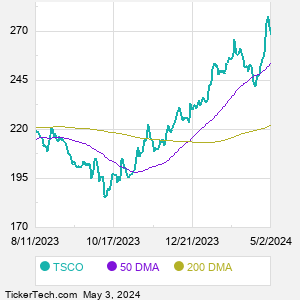| TSCO MACD Data | ||||||||||
Also see: |

| TSCO MACD Chart |
  |
| About Tractor Supply Co. |
| Tractor Supply is a rural lifestyle retailer. Co. is focused on supplying the needs of recreational farmers, ranchers and all those who enjoy living the rural lifestyle. Co. operates retail stores under the names Tractor Supply Company, Petsense, and Del's Feed & Farm Supply. Co.'s stores are located primarily in towns outlying metropolitan markets and in rural communities. Co. also provides an expanded assortment of products through the Tractor Supply mobile application and online at TractorSupply.com and Petsense.com. Co. has one reportable industry segment which is the retail sale of products that support the rural lifestyle. When researching a stock like Tractor Supply, many investors are the most familiar with Fundamental Analysis — looking at a company's balance sheet, earnings, revenues, and what's happening in that company's underlying business. Investors who use Fundamental Analysis to identify good stocks to buy or sell can also benefit from TSCO Technical Analysis to help find a good entry or exit point. Technical Analysis is blind to the fundamentals and looks only at the trading data for TSCO stock — the real life supply and demand for the stock over time — and examines that data in different ways. One of those ways is to calculate a Simpe Moving Average ("SMA") by looking back a certain number of days. One of the most popular "longer look-backs" is the TSCO 200 day moving average ("TSCO 200 DMA"), while one of the most popular "shorter look-backs" is the TSCO 50 day moving average ("TSCO 50 DMA"). A chart showing both of these popular moving averages is shown on this page for Tractor Supply. Comparing two moving averages against each other can be a useful visualization tool: by calculating the difference between the TSCO 200 DMA and the TSCO 50 DMA, we get a moving average convergence divergence indicator ("TSCO MACD"). The TSCO MACD chart, in conjunction with the chart of the moving averages, basically helps in visualizing how the moving averages are showing convergence (moving closer together), or divergence (moving farther apart). |
| TSCO Current Stock Quote |
Get Dividend Alerts Get SEC Filing Alerts |
| TSCO Stock Price Chart |
| Video: Technical Analysis | |
|
| TSCO MACD Peers |
| Tractor Supply (TSCO) is categorized under the Services sector; to help you further research MACD, below are some other companies in the same sector:
ULTA MACD |
